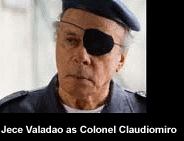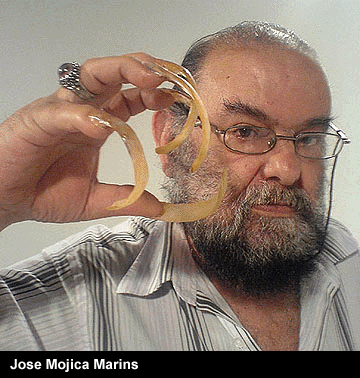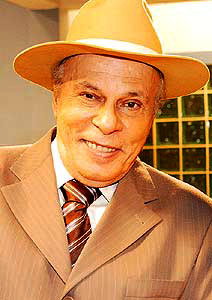

Nov. 27, 2006: Arrival in Sao Paulo
 The
plane lands at 10 a.m. A beautiful production assistant named
Bruna Marcatto, 22, meets me at Guarulhos International airport. I’m liking Sao
Paulo already. She pronounces my name as “Hey-moon.”
The
plane lands at 10 a.m. A beautiful production assistant named
Bruna Marcatto, 22, meets me at Guarulhos International airport. I’m liking Sao
Paulo already. She pronounces my name as “Hey-moon.”Bruna has worked on four films. The previous three were never completed. But this one will be completed because “Mojica is a very big filmmaker in Brazil,” she says. Filmmaking in Brazil is not the industry it is in America, she says. It is considered something exotic. Completing a film and getting it released in theaters is almost a miracle.
I told her I had been to Los Angeles and saw how filmmaking was very much an industry there. Everyone I met seemed to have some connection to the industry. Bruna says she would like to go there someday.
A driver takes Bruna and I to the hotel where I will spend the next
seven days. We pass crumbling slums and austere
skyscrapers. Sao Paulo is a huge metropolis. Up close, it
looks exactly like the city I have seen in Mojica’s films.
Its mix of urban and Third World reminds me of Cairo, where most of my
family lives. The comparison makes Sao Paulo seem familiar, as if
I am returning to a half-forgotten homeland.
 At the Heritage hotel, no one speaks English. Bruna translates
for the concierge, but then she has to leave for the production
office. A driver will return at 5 p.m. to take me to the set, she
says.
At the Heritage hotel, no one speaks English. Bruna translates
for the concierge, but then she has to leave for the production
office. A driver will return at 5 p.m. to take me to the set, she
says.
 At the Heritage hotel, no one speaks English. Bruna translates
for the concierge, but then she has to leave for the production
office. A driver will return at 5 p.m. to take me to the set, she
says.
At the Heritage hotel, no one speaks English. Bruna translates
for the concierge, but then she has to leave for the production
office. A driver will return at 5 p.m. to take me to the set, she
says.The hotel room is better than I expected. Two beds, a big bathroom with a shower and hydro-massage tub, a little fridge, television and a balcony with a nice view of the city.
Ever since I discovered Coffin Joe, I have fantasized about coming to Sao Paulo and meeting Mojica. I never thought it would happen, let alone under these surreal circumstances. I’m not just meeting him, not just appearing in his film, but I’m actually playing Coffin Joe! Yes, it’s just one scene, but still! This is incredible. Mojica is giving me a fantastic chance and I am determined not to disappoint him.
The hour comes. The driver arrives. I board a van, along with a veteran character actor named Rui Resende who is playing Ze do Caixao’s hunchbacked assistant, Bruno. At the time, I have no idea who Rui is. He is just a guy in the van. Throughout the week, I will be working alongside some of the top actors and technicians in Brazilian cinema, totally ignorant as to who these people are. My ignorance prevents me from being nervous around them, so maybe it is a good thing. Ah, but there is one person whose identity is very familiar to me. Around him, I am sure I will be quite nervous. Do I call him Mr. Marins? Mr. Mojica?
Rui says he worked all night and has had little sleep. Before
entering the van, he tried to wake up by drinking an espresso at a
little hole-in-the-wall café next to the hotel. But he is
still groggy. Making movies in Brazil is like war, he says.
It is chaotic, disorganized.

We arrive at the studio. From the outside, it looks like a rundown building. Inside, it looks like a haunted castle. The sets are fabulous. I meet several cast and crew, but Mojica is not there. None of the higher echelon is present – no producers, writers or director. Where are they? I sit in a white plastic chair facing the entrance and wait.
Mojica arrives. He looks tired and somber. I stand up and shake his hand. He nods and walks past. Something is wrong.
Then assistant director Dennison Ramalho enters. He has been my
main contact the last few months, communicating by phone and
e-mail. He recognizes me and gives me a hearty greeting.
Then he drops a bombshell.
 One of the principal actors, Jece Valadao, died of a heart attack 90 minutes ago.
One of the principal actors, Jece Valadao, died of a heart attack 90 minutes ago.
As I later learned from news reports, the 76-year-old Jece Valadao was one of the most famous and beloved actors in Brazil. A cultural icon. He specialized in playing tough-talking rogues, appearing in 106 movies. He debuted in the 1949 film, “Carnival of Fire.” One of his most famous films is “Rio, 100 Degrees F,” directed by Nelson Pereira dos Santos.
Dennison says Valadao was “the Jack Nicholson of Brazil.”
Mojica stands in the middle of the makeup room, his head low and his
shoulders slumped. Everyone is patting his back and hugging
him. Dennison walks up to him and explains who I am.
“Ooh…OOOH!” Mojica says. He gives me a big hug.
 Dennison gives me a tour of the facility and takes me outside to the
“back lot” where the crew has built a make-believe village
(a Brazilian slum called a favela). It may be low-budget by
Hollywood standards, but this is still a big production. There is
lighting and camera equipment everywhere, technicians running to and
fro.
Dennison gives me a tour of the facility and takes me outside to the
“back lot” where the crew has built a make-believe village
(a Brazilian slum called a favela). It may be low-budget by
Hollywood standards, but this is still a big production. There is
lighting and camera equipment everywhere, technicians running to and
fro.Dennison says Mojica has tried four times to make this movie since the 1960s, but each time someone has died and the production shuts down. The movie is cursed. “The devil is trying to stop Mojica from making this movie, but that will not happen this time,” he says. “This film will be completed. It must be.”
In “Encarnacao do Demonio,” Jece Valadao portrays Colonel Claudiomiro, the eye patch-wearing arch nemesis of Ze do Caixao. The colonel seeks vengeance after Ze gouged his left eye and seduced his wife. Valadao had completed about two-thirds of his scenes, but had not shot two critical sequences – the eye gouging scene and his death scene. Dennison thinks they should reshoot the scenes with a new actor, but Mojica and the producers want to keep Valadao in the movie. He is too big a star to cut, especially considering this is his final performance. As co-writer, Dennison will have to rework the script to accommodate the loss of Valadao. He is not sure what he is going to do, especially with the crucial eye gouging scene that establishes the antagonism between the colonel and Ze.
I say, “Just tell me to shut up if you don’t want suggestions.” He says, “No, believe me, we need suggestions right now.” I suggest that they make the eye gouging take place in the 1960s, when both the colonel and Ze were young men. Shoot the eye gouging as a flashback using a young actor playing the colonel. Dennison says that is the best idea anyone has come up with.
Mojica appears outside.  He and the producers huddle. Mojica
is sobbing. The producers are wiping their eyes. Mojica
sits in a chair in the middle of the village set. A producer
calls the entire cast and crew to gather around. A hush
falls. Mojica gives a 10-minute speech about Valadao, life and
death, the cinema. He’s speaking Portuguese, so I
can’t understand his words. But he speaks with such heart
that I feel I understand everything he says. His speech moves
everyone. He calls for a minute of silence, watching his
wristwatch as everyone hangs their heads. When the minute ends,
he says something like, “I can’t be Ze do Caixao
today,” and dismisses the crew. The producer tells everyone
to go home. The day is over.
He and the producers huddle. Mojica
is sobbing. The producers are wiping their eyes. Mojica
sits in a chair in the middle of the village set. A producer
calls the entire cast and crew to gather around. A hush
falls. Mojica gives a 10-minute speech about Valadao, life and
death, the cinema. He’s speaking Portuguese, so I
can’t understand his words. But he speaks with such heart
that I feel I understand everything he says. His speech moves
everyone. He calls for a minute of silence, watching his
wristwatch as everyone hangs their heads. When the minute ends,
he says something like, “I can’t be Ze do Caixao
today,” and dismisses the crew. The producer tells everyone
to go home. The day is over.
 He and the producers huddle. Mojica
is sobbing. The producers are wiping their eyes. Mojica
sits in a chair in the middle of the village set. A producer
calls the entire cast and crew to gather around. A hush
falls. Mojica gives a 10-minute speech about Valadao, life and
death, the cinema. He’s speaking Portuguese, so I
can’t understand his words. But he speaks with such heart
that I feel I understand everything he says. His speech moves
everyone. He calls for a minute of silence, watching his
wristwatch as everyone hangs their heads. When the minute ends,
he says something like, “I can’t be Ze do Caixao
today,” and dismisses the crew. The producer tells everyone
to go home. The day is over.
He and the producers huddle. Mojica
is sobbing. The producers are wiping their eyes. Mojica
sits in a chair in the middle of the village set. A producer
calls the entire cast and crew to gather around. A hush
falls. Mojica gives a 10-minute speech about Valadao, life and
death, the cinema. He’s speaking Portuguese, so I
can’t understand his words. But he speaks with such heart
that I feel I understand everything he says. His speech moves
everyone. He calls for a minute of silence, watching his
wristwatch as everyone hangs their heads. When the minute ends,
he says something like, “I can’t be Ze do Caixao
today,” and dismisses the crew. The producer tells everyone
to go home. The day is over.
Dennison says he has never seen Mojica cry. He says it must be
especially strange for me to meet my favorite horror star and find him
crying. Strange, yes, but disappointing? Hardly. It
confirmed what I knew all along. Mojica is not a cartoon
character. He is a passionate human being who cares about
people. I knew the artist who made those intensely personal films
had to have a big heart, and I was right. I also got to see what
a dynamic leader Mojica is during a crisis. He led by example,
with dignity and sincerity.
Back in the makeup/wardrobe room, Mojica sat down next to me.
Translating for him, an assistant explained to me that our first
meeting was not supposed to be like this. Mojica was very happy
to have me there, but this was a bad time. I said I understood, I
was very happy to be there, and I had the greatest respect for
Mojica. She translated my words and Mojica raised his hand as if
to deflect the compliment. His assistants helped him to his
feet. The producers cleared the building.Back at the hotel, Rui asked if I knew who Valadao was. I said no. He said, “We lost a very good friend today.”

